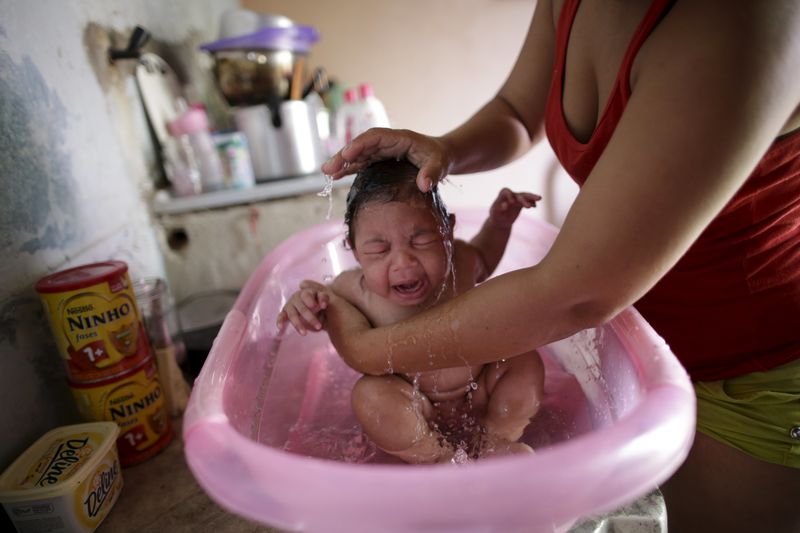By Bill Berkrot and Anthony Boadle
NEW YORK/BRASILIA (Reuters) - Experts on microcephaly, the birth defect that has sparked alarm in the current Zika virus outbreak, say they are struck by the severity of a small number of cases they have reviewed from Brazil.
Consultations among doctors in Brazil and the United States have increased in the last two weeks, and some of the leading authorities on the condition are finding patterns of unusual devastation in scans of the newborns' malformed brains.
While it's not known how representative the scans are, the early observations of these doctors point to a tough road ahead for the babies, their families and their communities and heighten the concern surrounding Zika, which is suspected of causing microcephaly.
"We are in the process of very rapid information gathering on what has been seen," said Dr. William Dobyns, a geneticist at Seattle Children's Hospital. "The condition that I've been able to review, very preliminarily, is more severe than simple microcephaly."
The Zika virus is transmitted by mosquito, causing mild symptoms in about 20 percent of cases, and most people experience no illness at all. But a spike in reported microcephaly cases among babies in areas of Brazil with Zika outbreaks has triggered an international effort to determine whether the virus causes the condition. The suspected association moved the World Health Organization (WHO) on Monday to declare an international health emergency.
Dobyns has spent 30 years researching and treating microcephaly, a condition defined by abnormally small heads in newborns that can lead to developmental disabilities, from mild to severe. The U.S. Centers for Disease Control and Prevention (CDC) has sought out his expertise in understanding the unfolding epidemic.
With a small group of geneticists and other microcephaly specialists, he recently reviewed scans of a handful of babies sent by a colleague in Brazil. All the experts were struck by the scale of malformations, he said.
"These children have a very severe form of microcephaly," Dobyns said. "The brain is not just small, it's small with malformations of the cerebral cortex and calcifications. It has the appearance of a very severe, destructive injury to the brain."
Particularly alarming, Dobyns said, is the presence in the Brazilian cases of excess spinal fluid between the brain and skull of the babies.
"If the brain is growing and then suddenly shrinks, then you'll see fluid between the brain and skull," he said. "It has a pattern that suggests that the brain has actually decreased in size."
Dr. Leonardo Vedolin, a neuroradiologist and researcher at the Moinhos de Vento hospital in Porto Alegre, Brazil, shared with Dobyns scans of two more microcephalic babies this week. The doctors belong to a brain defects study group that convenes via video conference each month. The group is now focussed on Zika.
Neither Vedolin nor Brazil's Health Ministry were able to provide a breakdown on the severity of confirmed microcephaly cases. In general, Vedolin said, 5 percent of microcephaly cases are severe. But the proportion appears greater among the cases in Brazil, he said.
THE CASELOAD
Public health officials in Brazil are investigating more than 4,000 cases of suspected microcephaly, and have confirmed more than 400. Prior to the Zika outbreak, Brazil saw on average 163 cases annually of microcephaly over the past five years, according to WHO. In 17 of the new cases, the presence of Zika was identified in the mother or the baby.
A study of 35 Brazilian babies born with microcephaly during the Zika outbreak reported by the CDC Jan. 29 added strength to the suspected connection.
The mothers of all 35 infants had lived in or visited Zika virus-affected areas during pregnancy, the report said. Twenty-five infants had severe microcephaly, and 17 had at least one neurologic abnormality.
Dr. Frank Esper, an infectious disease expert from Rainbow Babies & Children's Hospital in Cleveland, said he expects a steady wave of studies on Zika and microcephaly that will provide a much clearer picture over the first half of 2016.
By the broadest definition, about 2.3 percent of all babies are microcephalic, Dobyns said. Some cases are so mild they involve no complications at all.
About one tenth of one percent of the cases are so severe that lifelong care is required, he said. There are many known causes, including a wide range of genetic disorders such as Down syndrome, as well as oxygen deprivation to the fetus, cytomegalovirus and severe fetal alcohol syndrome.
Lifespan in severe cases can be months or as long as 10 years, depending on proximity to good medical care, Dobyns said.
Dr. Dawn Nolt, a member of the American Association of Pediatrics' (AAP) Committee on Infectious Diseases, and other doctors, said more severely affected children often require treatment for epileptic seizures, as well as physical, respiratory and speech therapy. They may need help with everyday activities, such as eating or walking.
"It's crucial to go to a care centre with good neurology and genetics teams that can evaluate the child comprehensively," said Dr. Ghayda Mirzaa, a pediatric neurologist and colleague of Dobyns at Seattle Children's.
Doctors in Recife, Brazil are sending mothers with afflicted babies for therapy to help stimulate eyesight, hearing and motor skills to minimize retardation in mental and physical development.
There are a handful of centres of microcephaly research and treatment in the U.S., including Dobyns' hospital in Seattle. The consultations of physicians like Dobyns in the Brazil cases is informal at this point but could form the basis for an organised exchange of expertise that will inform the ongoing care of the children of the epidemic.

"We need to get the message out that this is real, and coming, without getting everybody to panic," Dobyns said. "There will be a steep curve of new information coming in."